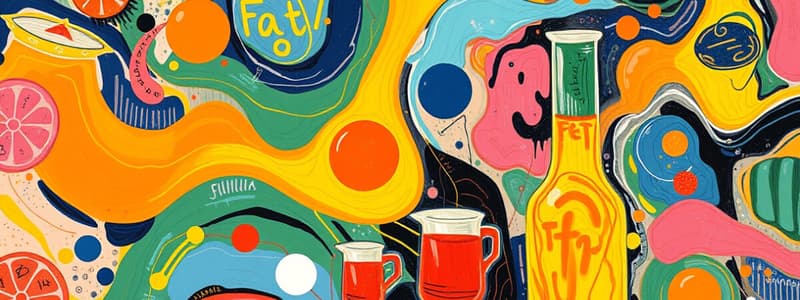Podcast
Questions and Answers
What role do phospholipids play in food products such as mayonnaise and salad dressings?
What role do phospholipids play in food products such as mayonnaise and salad dressings?
- They serve as an emulsifier to mix fats with water. (correct)
- They act as a preservative.
- They enhance the sweetness of the product.
- They provide essential vitamins.
Which of the following statements is true regarding cholesterol?
Which of the following statements is true regarding cholesterol?
- Exogenous cholesterol is produced by the liver.
- Endogenous cholesterol is the cholesterol obtained from dietary sources.
- Cholesterol can accumulate in artery walls leading to atherosclerosis. (correct)
- Cholesterol is primarily eliminated from the body through urine.
What is the primary site for fat digestion in the body?
What is the primary site for fat digestion in the body?
- The stomach
- The liver
- The small intestine (correct)
- The mouth
What triggers the release of bile into the small intestine?
What triggers the release of bile into the small intestine?
What are the constituents of cell membranes that help fat-soluble substances pass through?
What are the constituents of cell membranes that help fat-soluble substances pass through?
Which type of fats spoils most readily due to their structural properties?
Which type of fats spoils most readily due to their structural properties?
What are natural trans-fatty acids derived from?
What are natural trans-fatty acids derived from?
What is the role of lecithin in phospholipids?
What is the role of lecithin in phospholipids?
What is a major health disadvantage of trans-fatty acids?
What is a major health disadvantage of trans-fatty acids?
Flashcards are hidden until you start studying
Study Notes
Degree of Unsaturation and Stability
- Unsaturated fats are more prone to spoilage when exposed to oxygen, light, and heat.
- Rancidity in fats produces off-flavors and odors from oxidation, especially prevalent in polyunsaturated fats due to their unstable double bonds.
Hydrogenation Process
- Hydrogenation adds hydrogen to unsaturated fatty acids, converting them to saturated fats, which enhances oxidation resistance.
- This process also creates trans-fatty acids, altering the texture of oils to make them more solid.
- Hydrogenation increases shelf life and stability of polyunsaturated fats in food products.
Cis vs. Trans Fatty Acids
- Most natural double bonds in fatty acids are cis, meaning hydrogens are on the same side of the carbon chain.
- Trans fatty acids have hydrogens on opposite sides, and they occur naturally in small amounts in certain milk and meat products.
- Trans fats behave similarly to saturated fats in the body, raising blood cholesterol and increasing heart disease risk.
Phospholipids
- Phospholipids consist of glycerol, two fatty acids, and a phosphate group, distinguishing them from triglycerides.
- Lecithin is a type of phospholipid used as an emulsifier in food products like mayonnaise and salad dressings.
- Natural sources of lecithin include eggs, liver, soybeans, wheat germ, and peanuts.
- Phospholipids are essential for cell membranes and help transport fat-soluble substances in and out of cells.
Sterols and Cholesterol
- Sterols have a four-ring carbon structure with varying side chains; cholesterol is a type of sterol important for the formation of bile acids and hormones.
- Cholesterol can be endogenous (produced by the body) or exogenous (obtained from food), with the liver producing 800 to 1500 milligrams daily.
- Accumulation of cholesterol in arteries can lead to plaque formation and atherosclerosis, increasing the risk of heart attacks and strokes.
Fat Digestion
- The digestion of fats begins in the mouth, where some fat is melted by body temperature and salivary lipase helps in infants.
- Most fat digestion occurs in the small intestine, where the presence of fat triggers the release of cholecystokinin (CCK).
- CCK stimulates the gallbladder to release bile, which emulsifies fats and aids in their digestion and absorption.
Studying That Suits You
Use AI to generate personalized quizzes and flashcards to suit your learning preferences.




